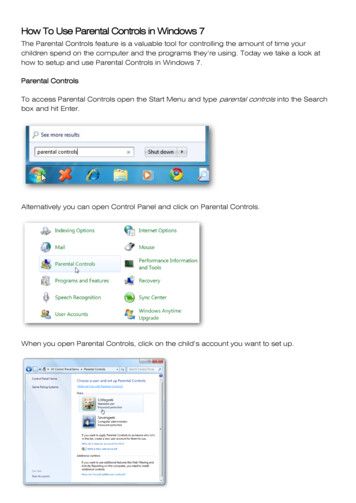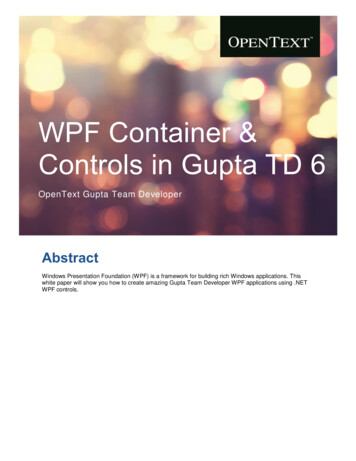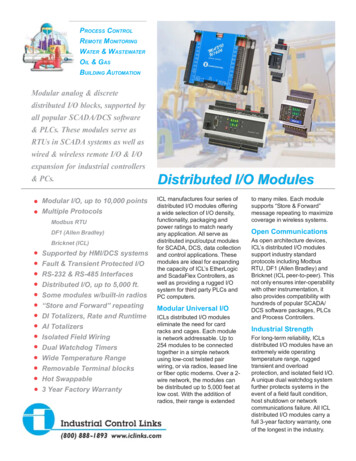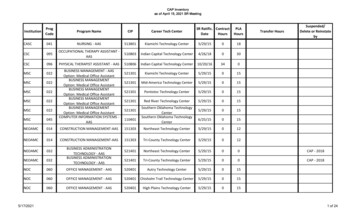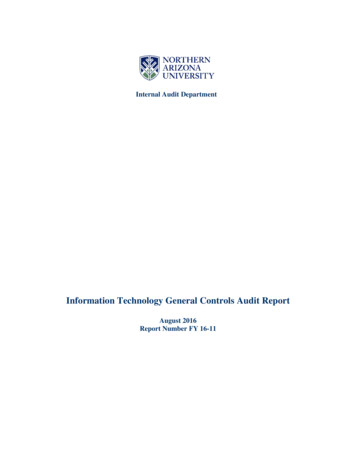
Transcription
Technical Reference ManualScadaFlex MicroBrickDistributed I/O & RTU Modules Multiple Models Available:32 Discrete Inputs (12/24 or 120V)16 Discrete Relay Outputs32 Discrete FET (protected transistor) Outputs16 Discrete Inputs 16 Discrete FET Outputs16 16-bit Analog Inputs8 16-bit Universal (AI/Sensor) Isolated Inputs12 16-bit Universal (AI/Sensor) Inputs8 16-bit Analog Inputs and 8 12-bit Analog OutputsCombo [6 16-bit AI, 10 DI (12/24 or 120V), 4 DO ]Modular I/O Expansion to 8000 points distributed over4,000ft.Built-in local Operator Interface; View and Force I/O,configure module locallySupport for Modbus RTU, BrickNet peer-to-peer, and DF1communicationsBack-to-back I/O bridge – Master ModeBuilt-in “store-and-forward” messaging for radio basedsystemsIsolated dual-standard communications interface; RS-232 and RS-485All I/O is isolated and transient, surge, overload and polarity protectedAll Discrete Inputs have pulse and runtime totalizers, and rateAll Discrete Outputs have programmable Flash functionAll Analog Inputs have totalizers with programmable sampling timeDual Watchdog Timers; Comm & Module CPULow-power DC for battery/solar applicationsHot-swappable with removable terminal blocksDiscrete I/O have individual LED status indicatorsCompact & DIN rail mounting for lower panel cost-40ºC to 75ºC Operating Temperature Range3-year factory warrantyMicroBrick Distributed I/O
MicroBrick Distributed I/O ModulesTechnical Reference ManualCopyright NoticeThis document is copyrighted, 2007, by Industrial Control Links, Inc.All rights are reserved.Industrial Control Links, Inc. reserves the right to make improvements to the products described in this manual at anytime without notice.No part of this manual may be reproduced, copied, translated or transmitted in any form or by any means without theprior written permission of Industrial Control Links, Inc. Information provided in this manual is intended to be accurateand reliable. However, Industrial Control links, Inc. assumes no responsibility for its use, nor for any infringementsupon the rights of third parties which may result from its use.AcknowledgmentsScadaFlex, ScadaFlex Plus, ScadaWorks and ScadaBuilder are trademarks of Industrial Control Links, Inc.ISaGRAF is a trademark of ICS Triplex, Inc.2Copyright 2007 Industrial Control Links, Inc. All Right Reserved
MicroBrick Distributed I/O ModulesIn This Manual . . .This manual provides the technical hardware information required for system designand installation of MicroBrick Distributed I/O Modules.If you have just purchased a MicroBrick, we hope that you are as pleased using it aswe have been developing it.If you are reading this manual looking at a future purchase, we hope that you willconsider MicroBrick I/O when you have an application that needs modular I/Oexpansion, either locally or over several thousand feet.SupportIf you have questions or need help with an application, we hope that you’ll takeadvantage of our free technical support. Simply call us at:(800) 888-1893If you need to send us a fax, use either:(530) 888-1300 or (530) 888-7017If you prefer e-mail, especially if you want to send us a sample of a program or otherfiles, you can e-mail us at:support@www.iclinks.comFor additional technical information including datasheets, manuals and software, visitour web site at:www.iclinks.comCopyright 2007 Industrial Control Links, Inc. All Right Reserved3
MicroBrick Distributed I/O Modules4Copyright 2007 Industrial Control Links, Inc. All Right Reserved
MicroBrick Distributed I/O ModulesCertificationsMicrobricks are tested to the following certifications:North America:UL 508, CSA 142, ANSI/ISA-12.12.01-2000: April , CSA-C22.2 NO. 213-Ml987 (R 1999); Class IDivision 2 Groups A, B, C, and D: by INTERTEK.European Union:EN 60079-15: Sept 2003 ATEX Group II Category 3 Gas Vapor or Mist Explosion protectionProtection Type nA: In normal and some abnormal conditions, the equipment is not capable of igniting anexplosive gas atmosphere.All certified PicoBrick I/O Modules come with the following compliance marking tagATEX Explosion protection Group II Category 3, Gas Vapor ormist (not suitable for incendiary dust environments).CE Certification MarkingClass 1 Div 2Compliance“X” Device must be installed within anIP56, IP54, Nema 4, or Nema 4xenclosure. External surgesuppression must be installedexternally to limit input voltage to140% of operating voltages.“T4” Rating to130ºC MaximumSurfaceTemperatureAmbient OperatingTemperatureClass 1 Div 2WarningATEXWarningCopyright 2007 Industrial Control Links, Inc. All Right Reserved5
MicroBrick Distributed I/O ModulesContentsIn This Manual . . .3Support.3Certifications.5North America: . 5European Union: . 5Contents .6Introduction.10Modular I/O Expansion. 10Operator Interface . 10Built-in Networking . 10Open Architecture. 10Peer-To-Peer Communications. 10Back-To-Back I/O Bridge – Master Mode . 11Local I/O Processing. 11Wide Power Range and Low Power Operation . 11Rugged I/O. 11Industry Leading Warranty . 11Register Map – ALL MICROBRICKS. 12Specifications – ALL MICROBRICKS. 12MicroBrick Familiarization .14Operator Interface.16Main Menu. 18MicroBrick Type Specific Menus. 19Power.23Power Wiring . 23Communications Interfaces.24RS-232 Serial Communications Interface . 24RS-485 Serial Communications Interface . 24Typical ScadaFlex Plus/MicroBrick RS-485 Network. 25Modbus Communications.26Network Addressing . 26Store & Forward . 26Modbus Message Store and Forward Address Translation . 28BrickNet Communications.28Create a BrickNet Network Session. . 29DF1 Communications.33Maintenance.34Analog Calibration. 34Firmware Updates. 34Installation.34Mechanical Installation. 34North America: . 34European Union: . 34Electrical Installation . 35Discrete Input Modules .376Copyright 2007 Industrial Control Links, Inc. All Right Reserved
MicroBrick Distributed I/O ModulesSignal Types and Levels . 37LED Input Status Indicators. 37I/O Processor Functions. 37Input Filtering . 37Pulse Totalization. 38Runtime Totalization . 38Pulse Rate Calculation . 38Operator Interface . 38Field Wiring . 39Register Map - Discrete Input MicroBricks. 40Specifications - Discrete Input MicroBricks. 40Discrete Output Modules .4116 Relay Output Module. 4132 FET (Protected Transistor) Output Module. 41LED Output Status Indicators. 41I/O Processor Functions. 42Operator Interface . 42Field Wiring . 42Register Map - Discrete Output MicroBricks . 44Specifications - Discrete Output MicroBricks . 44Analog Input Module .45Signal Types and Levels . 45Isolation and Input Protection. 45I/O Processor Functions. 45Calibration. 46Operator Interface . 46Field Wiring . 46Register Map - Analog Input MicroBrick. 48Specifications - Analog Input MicroBrick. 48Universal Input Modules .49Input mode Configuration. 49RAW Mode. 495Vdc Mode. 5020mA Mode . 50Millivolt Mode. 50Thermocouple Modes . 51Resistance Type Sensor Modes . 52Resistance Mode (2-wire) . 52Thermistor Modes. 52RTD Modes. 54Contact Closure and Logic Level Discrete Inputs . 56Operator Interface . 56Field Wiring . 57Register Map - Universal Input UI8I And UI12. 59Specifications - Universal Input MicroBrick . 60Discrete I/O Modules .61Discrete I/O Module Discrete Input Section. 61Copyright 2007 Industrial Control Links, Inc. All Right Reserved7
MicroBrick Distributed I/O ModulesSignal Types and Levels . 61LED Input Status Indicators. 61I/O Processor Functions. 61Input Filtering . 61Pulse Totalization. 62Runtime Totalization . 62Pulse Rate Calculation . 62Discrete I/O Module Discrete Output Section . 62LED Output Status Indicators. 63I/O Processor Functions - Discrete Outputs. 63Operator Interface . 63Discrete I/O Module Field Wiring. 63Modbus Register Map. 65Specifications - Discrete Input PicoBricks . 65Analog I/O Module .66Analog I/O Module Analog Input Section. 66Signal Types and Levels . 66Isolation and Input Protection. 66I/O Processor Functions. 67Analog Input Calibration . 67Operator Interface . 67Analog I/O Module Analog Output Section . 68Signal Types and Levels . 68Isolation and Output Protection . 68Calibration. 68Field Wiring . 68Modbus Register Map. 70Specifications - Analog I/O MicroBrick. 70Combo I/O Modules.71Combo Module Discrete Input Section. 71Signal Types and Levels . 71LED Input Status Indicators. 71I/O Processor Functions. 71Input Filtering . 72Pulse Totalization. 72Runtime Totalization . 72Pulse Rate Calculation . 72Combo Module Discrete Output Section. 72LED Output Status Indicators. 73I/O Processor Functions. 73Combo Module Analog Input Section . 73Signal Types and Levels . 73Isolation and Input Protection. 74I/O Processor Functions. 74Analog Input Calibration . 74Operator Interface . 75Combo Module Field Wiring. 758Copyright 2007 Industrial Control Links, Inc. All Right Reserved
MicroBrick Distributed I/O ModulesRegister Map - Combo I/O MicroBricks . 77Specifications - Combo I/O MicroBricks . 77Copyright 2007 Industrial Control Links, Inc. All Right Reserved9
MicroBrick Distributed I/O ModulesIntroductionMicroBricks are easy-to-use distributed I/O modules. They can be interconnected withScadaFlex or EtherLogic controllers for I/O expansion, connected to ProgrammableLogic Controllers (PLCs) or PC computers as rugged field I/O, or used with radios orleased-line modems to serve as low-cost Remote Terminal Units (RTUs).MicroBricks go beyond traditional “dumb” I/O modules by providing local intelligentsignal conditioning and data acquisition functions, as well as a local operator interfacethat can eliminate the need for laptop PCs, simulators or display terminals in the field.Modular I/O ExpansionMicroBricks provide a very modular means of adding I/O capacity as needed, withoutthe extra cost, wasted space and constraints of card racks. Need more I/O? Snap on amodule. Want to add some I/O a few hundred yards away? String a single twisted pairof wires and you’re up and running!Operator InterfaceAll MicroBricks come with a built-in alphanumeric operator interface and a simplified4-key keypad. This interface allows analog input and output levels to be displayed (likea panel meter), and allows both analog and discrete inputs and outputs to be forced(local override). The operator interface also supports I/O Module configurationfunctions such as network address, display brightness and power-saver timeout. TheLED display is bright enough for readability outdoors, and rated to withstand the widetemperature extremes that MicroBricks are designed for; -40ºC to 75ºC.Built-in NetworkingMicroBricks come network-ready with an isolated, dual-function (RS-485 and RS-232)serial communications interface. The RS-485 port can be used for low-cost 2-wirenetworking while RS-232 is a simple point-to-point interface to radios and modems aswell as PCs. MicroBricks support “store-and forward” messaging to extend the effectiverange of radio based systems by using the RTU as a digital repeater, withoutadditional radio hardware.Open ArchitectureMicroBricks use the Modbus RTU protocol, one of the most common protocols used incontrol systems. This protocol is supported by thousands of other hardware andsoftware products including all of the common PC-based MMI software packages frommanufacturers such as Wonderware, Intellusion, Iconics, and National Instruments.Peer-To-Peer CommunicationsFor true peer-to-peer operation MAXIO modules support ICL’s BrickNet protocol foruse with ICL EtherLogic and ScadaFlex Plus controller families. Protocol detectionbetween Modbus and BrickNet is automatic.10Copyright 2007 Industrial Control Links, Inc. All Right Reserved
MicroBrick Distributed I/O ModulesBack-To-Back I/O Bridge – Master ModeSome MicroBrick modules support a back-to-back I/O mirroring operation. This“Master mode” feature allows for the inputs on one module to be mirrored as outputson a remote module, and visa versa. This setup is designed to work with only a twounit network.Local I/O ProcessingMicroBricks perform local I/O processing to off-load time-sensitive operations from aHost system.MicroBricks with Discrete Inputs totalize input transitions and on-time (runtime) andcalculate pulse rates for every input. Applications include using digital pulse outputmeters for precise totalized flow and wattage calculations, as well as real-time flow rateand power usage information. Runtime is widely used for wear leveling betweenpumps or motors, and as the basis of an equipment preventive maintenance program.MicroBricks with Analog Inputs totalize the value of every Analog Input at a periodicsampling rate, especially useful for totalized flows and wattage applications usinganalog output type meters.MicroBricks with Discrete Outputs can be commanded to flash individual outputs at aprecise periodic rate independent of communications and I/O scan rates, primarily forvisual alarm annunciation.Wide Power Range and Low Power OperationMicroBricks are designed for use in solar and battery backed applications. Theyoperate over a wide range of DC power (10 to 30Vdc) and have built-in features tominimize their power usage. For example, the bright LED display used for the operatorinterface represents a significant portion of the modules power consumption. A userconfigurable power saver timer turns off the display when there has been no activity atthe keyboard for a while, but automatically turns on the display when any key ispressed.Rugged I/OAll I/O and communications interfaces are isolated and protected against overloads,transients, surges, and reverse polarity. Self resetting polymer fuses are usedthroughout. When the fault condition is corrected, the module automatically resumesnormal operation.Industry Leading WarrantyMicroBricks are backed by an industry leading 3-year factory warranty.Copyright 2007 Industrial Control Links, Inc. All Right Reserved11
MicroBrick Distributed I/O ModulesRegister Map – ALL MICROBRICKSSTATUS (Read Only Input Bits - Modbus Type 10xxx)I/O specific only (no common Statusess)COILS (Read/Write Output Bits - Modbus Type 00xxx)I/O specific only (no common Coils)INPUT REGISTERS (Read Only 16-bit - Modbus Type onReserved - ICL Test ONLYInput Voltage (power) x 10 (143 14.3 volts)Reserved - ICL Test ONLYFirmware RevisionDevice ID (DI32-24 2211, DI32-120 2212, DO32-24 2221, DO16-RLY 2222, AI16-16 UI8I 2233, UI12 2232, DIO16/16-24 2255, DIO 16/16-120 2256, AO8-12I 2142,Combo-24 2251, and Combo-120 2252)HOLDING REGISTERS (Read/Write 16-bit - Modbus Type 253254255256End-DescriptionInput Power (voltage) calibration numerator (denominator 65,535)Bricknet/DF1 Character Gap Message TimeoutMaster Mode Poll Retries (if Master Mode supported)Master Mode Poll Time 10mS Increments (if Master Mode supported)Master Mode Response Timeout 10mS Increments (if Master Mode supported)Store & Forward - Incoming Base AddressStore & Forward - Outgoing (remapped) Base AddressStore & Forward - Address Range (block size)Communications Watchdog Timer (10mS increments)Xmit Enable Delay (Xmit Enable to Xmit Data in 10mS increments)Power Save Time (No keypad activity to display turn off in seconds, 0 disable)Display Brightness ( 0 to 127, 0 is OFF)DF1 mode (0x00 Modbus/BrickNet, 0xDF DF1)Baud Rate Index (0 2400, 1 4800, 2 9600, 3 19200, 4 38400, 5 115200)Status Register (0001h restarted, 0002h comm. timed out, 0010h keyboard locked)Reserved - Test Register - ICL Test ONLYReserved - Control
For true peer-to-peer operation MAXIO modules support ICL's BrickNet protocol for use with ICL EtherLogic and ScadaFlex Plus controller families. Protocol detection between Modbus and BrickNet is automatic.
